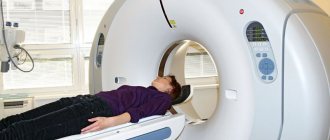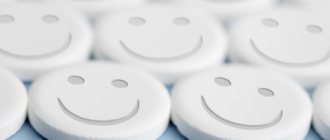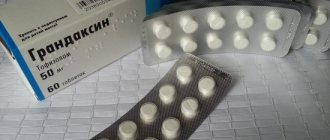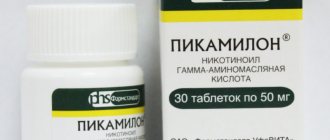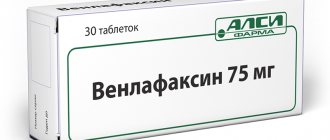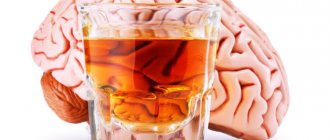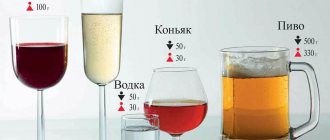Most antidepressants should never be combined with alcohol. Alcohol entering the bloodstream can dramatically increase the risk of side effects and lead to serious consequences. One of the fairly common drugs prescribed for depression is Zoloft. Let's look at the possible consequences that arise if you combine Zoloft and alcohol.
Velaxin and alcohol compatibility
What antidepressants can alcohol be combined with?
Selective serotonin reuptake inhibitors
The highlight of the actions of selective serotonin reuptake inhibitors: they are able to inhibit the process of serotonin uptake by neurons, which causes serotonin to begin to accumulate in synaptic clefts.
Therefore, in those areas where neurons can connect to each other, the volume of serotonin increases. And when there is a lack of this serotonin, this is one of the common factors that cause depression to appear and develop in a person.
SSRIs are medications that contain the following substances:
- fluoxetine (such drugs contain this substance: Deprex, Fluval);
- sertraline (Aleval, Asentra, Sirlift);
- paroxetine (adepress, rexetine);
- citalopram (Oprah, Pram, Tsipramil, Citol);
- escitalopram (Lenuxin, Selectra);
- fluvoxamine (fevarin);
- venlafaxine (Velaxin, Efevelon);
- duloxetine (Cymbalta).
You should not mix alcohol with selective serotonin reuptake inhibitors because alcohol itself has the ability, for a period of time, to continue the life and work of serotonin, and at the same time it is also considered an inducer of dopamine synthesis, just like antidepressants cannot be associated and interact with alcohol.
From this it turns out that, if you look from this point of view, during the use of alcohol and drugs for relieving depression, a struggle for the substrate will occur, and what will happen is that not only the usual effect of antidepressants will be enhanced, but also their negative effects, or rather side effects.
To find out what negative effects there may be, you can read them in the instructions for the drug, which describe the full use of the drug.
But in the description you can read that these effects can also appear with proper use: from the polymorphism of serotonin receptors, there is a possibility that side effects will develop that are completely opposite to what the drug was supposed to do for the body.
It depends on which receptors will be under the influence of the antidepressant - the receptor that was essentially supposed to be affected by the drug or the opposite receptor.
Both are serotonin. And when you drink alcohol and antidepressants at the same time, serotonin receptors of various types will succumb to excitement, which will lead to unpredictable actions. And such a cocktail can easily cause hallucinations and increased aggression.
But it is also very dangerous to get vegetative disorders: jumps with blood pressure, disruption of the blood process, namely coagulation, arrhythmias and various other disorders.
The companies that create antidepressants write in the instructions that it is not recommended to combine alcohol with their drugs, but they also write that when conducting studies, there were no changes in healthy people when combined with alcohol.
Reviews about "Velaxin"
Doctors generally give the drug positive characteristics. They cite the high effectiveness of the product, its safety, low risks of overdose or addiction if the rules of therapy are followed. According to official statistics, the body’s negative response to the drug rarely develops, and side effects do not cause significant discomfort.
Consumer reactions to the antidepressant are mixed. Some note its therapeutic effect and confirm an improvement in the quality of life after a course of medication. Others claim that, despite following medical recommendations, they experienced significant side effects, developed drug dependence, and experienced withdrawal symptoms. Patients often complain that discomfort persists for a long time after stopping the medication. The high cost of the product is another disadvantage. Today in pharmacies you can find a lot of cheaper analogues of the composition.
Tricyclic antidepressants
Read also: Is it possible to drink formic alcohol
These are drugs whose composition consists of such substances as:
- amitriptyline (such drugs contain this substance: tryptisol, elivel);
- clomipramine (anafranil, clofranil);
- imipramine (melipramine);
- tianeptine (Coaxil);
- pipofezin (azafen).
Three-cycle antidepressants are very toxic, and therefore you should not mix them with alcohol and add a new portion of toxins to the body.
Tricyclics have many negative effects, including very difficult ones - if there were toxins in the blood from alcohol, it can increase the risk of these diseases, including quite difficult and severe ones.
These antidepressants should not be taken, not only with alcohol, but also with various types of foods and medications, so be very careful before taking tricyclics.
Interaction
The combination of the drug with MAO inhibitors is strictly prohibited. You can start taking Velaxin no earlier than 2 weeks after giving up such products. They can also be included in the treatment regimen a week after stopping the use of an antidepressant.
Taking Velaxin with other medications can cause the following consequences:
- the pharmacokinetics of lithium preparations will not change, but their concentration in the blood may be increased;
- the effects of Haloperidol are enhanced;
- the likelihood of developing side effects from Clozapine increases. In particular, there is a risk of epileptic seizures;
- the anticoagulant properties of Warfarin are enhanced;
- the effect of the active metabolites of Imipramine becomes more pronounced.
The medicine enhances the effect of Haloperidol.
Alcohol in combination with Velaxin causes pathological changes in psychomotor reactions. The consequences of such a combination can be the most unexpected and life-threatening.
MAO inhibitors
MAO inhibitors are very active drugs that can inhibit (in simple words they can slow down the enzyme reaction) monoamine oxidase.
These are drugs that contain substances such as:
- moclobemide (such drugs contain this substance: aurorix);
- pirlindol (pyrazidol).
While you are using MAO inhibitors, you will need to avoid drinking alcohol to avoid theramine or serotonin syndrome. Drinking alcohol while you are undergoing treatment with MAO inhibitors has a chance of causing your respiratory center to become depressed.
When taking antidepressants of this particular type, you should be on a certain diet, since there are many foods and medications with which it should not be used.
Look at the instructions for this drug, or for the drugs that are in your home: the instructions for most will write that it is not recommended to combine the drug with a medicine that contains MAO inhibitors.
What antidepressants can alcohol be combined with?
As the safest option, experts consider the combined use of strong drinks and antidepressant drugs created using ademetionine or the herb St. John's wort. To avoid negative reactions, doses of alcohol should be small. During the week, you are allowed to take alcohol once in doses that are not capable of provoking the development of a hangover syndrome. The maximum permissible portion of a strong drink (cognac, vodka) is 1 glass.
Antidepressants that can be treated with alcohol include:
Other groups of antidepressants
| quote: |
| Message from blue_helmet Hello everyone! I would be very grateful if someone helps. |
I have been taking venlafaxine (Velafax) for 9 days, dosage 150 mg (I got used to it quickly). The problem is that I began to choke on it (for several days now). When the concentration of the substance drops (I drink in 2 doses), it lets me go for a while. I take the dose and do it all over again. This is very painful, I can’t breathe, I’m suffocating like an asthmatic (I used to have this happen due to severe stress - there are clearly problems with my heart). I get up abruptly, my ears pop and I fall. My heart is beating fast and hard, my hands are shaking. But the worst thing is this respiratory failure. I tried breathing in different ways, but it didn't work. My head is spinning and I’m covered in sweat. Severe weakness.
Should I continue taking it? It’s difficult to even stand in this state. Thank you in advance! Hello! I have not had this happen, consult the doctor who prescribed this medicine.
I dropped to 17.5 mg. Velaxin, took it, then quit. For 3 days now, withdrawal symptoms have been tormenting me, severely. Weakness, bad mood, aggression, palpitations, crying, it’s like electric shocks, I’m taking half of alprazolam and valerian. It’s hard to look with my eyes, my vision is slow, drowsiness is very strong I don’t know how long this will last(((It’s hard. Maybe someone can tell me something?
| quote: |
| Message from Olympia |
| quote: |
| Message from blue_helmet Hello everyone! I would be very grateful if someone helps. |
I have been taking venlafaxine (Velafax) for 9 days, dosage 150 mg (I got used to it quickly). The problem is that I began to choke on it (for several days now). When the concentration of the substance drops (I drink in 2 doses), it lets me go for a while. I take the dose and do it all over again. This is very painful, I can’t breathe, I’m suffocating like an asthmatic (I used to have this happen due to severe stress - there are clearly problems with my heart). I get up abruptly, my ears pop and I fall. My heart is beating fast and hard, my hands are shaking. But the worst thing is this respiratory failure. I tried breathing in different ways, but it didn't work. My head is spinning and I’m covered in sweat. Severe weakness.
Read also: How much money does one spend on cigarettes per month?
Release form and composition
The release form is in the form of solid white and yellow spherical particles, coated, which are enclosed in hard gelatin capsules with a modified release. One blister pack contains 14 capsules. One cardboard box contains capsule forms with a total of 28 pieces and instructions for use.
The main active ingredient in the formula is venlafaxine hydrochloride. Additional components declared include mineral talc, microcrystalline cellulose, linear polymer of dimethylsiloxane, sodium chloride, potassium salt of hydrochloric acid, colloidal silicon dioxide, corn sugar gum, copovidone, food additive E 172 (yellow and red), partially hydrolyzed collagen protein, titanium dioxide.
Pharmacological properties
In our difficult times, stress and depression have become an integral part. Increased multitasking, constant haste, nervousness, lack of proper rest - all these factors take a lot of mental and physical strength from a modern person. Because of this, there is an accumulation of fatigue, dissatisfaction with life, tension, which provokes the emergence of various psychological problems that threaten serious negative consequences. There is a misconception that you can easily get rid of these problems on your own, without the help of professionals. In fact, if there is a depressed mood and loss of interest in previously loved activities for at least two weeks, then we can say with complete confidence that the person has a depressive syndrome. The development of this disease threatens a person with the appearance of cardiovascular pathologies, type 2 diabetes, an increase in the risk of obesity by 58%, an impact on the immune system, weakening it and provoking the occurrence of viral diseases and potentiating the development of cancerous tumors. A person who has been diagnosed with depression experiences a craving for suicidal thoughts, as well as an increased interest in tobacco products, drugs and alcoholic beverages, the use of which only aggravates the condition and complicates treatment. Doctors often include antidepressants as part of complex treatment, which are designed to stabilize the emotional background, reduce anxiety and restlessness, block inhibition, and increase mental activity and movement. One of the most effective pharmaceuticals in this group is Velaxin, which is used to treat diseases from the nosological classification such as bipolar affective disorder, depressive episode, recurrent depressive disorder, as well as mixed anxiety and depressive disorder.
The antidepressant effect of Velaxin is determined by its unique composition, which includes active equimolar mixtures of two enantiomers. By enhancing the influence of hormones in the brain that transmit information from one neuron to another, venlafaxine and O-desmethylvenlafaxine affect the reuptake of serotonin, norepinephrine, dopamine and other neurotransmitters.
Types of psychotropic drugs
Based on the mechanism of action, the following types can be distinguished:
- sedatives;
- tranquilizers;
- neuroleptics;
- antidepressants.
- Sedatives are prescribed for sleep disorders, nervous tension, and increased irritability as sedatives that regulate the activity of the central nervous system. The action is based on enhancing inhibitory processes in the nerve cells of the cerebral cortex.
- Tranquilizers relieve internal tension, fear and anxiety. They have a fairly pronounced relaxing and hypnotic effect. Tranquilizers are prescribed for neuroses of various origins, before surgery as part of anesthesia, and also for alcoholism as part of a complex treatment for addiction. You can take such tablets for no more than a month to avoid addiction.
- Neuroleptics are prescribed to people suffering from serious mental pathologies. These may be congenital or acquired disorders such as schizophrenia, manic-depressive psychosis, or reactive disorders caused by shock. The drugs have a strong sedative effect and inhibit the activity of the central nervous system.
- Antidepressants are prescribed for a general depressed, apathetic state to increase the activity of the central nervous system to normal levels. Designed for long-term use - from six months to a year, the effect can be noticed after 2-3 weeks of taking the tablets.
Antidepressants are prescribed for a general depressed state to increase the activity of the central nervous system to normal levels
Method and features of application
Velaxin should be used purely orally and only when the diagnosis is confirmed by the attending physician. The normalized daily dosage is one capsule, which should be taken with a meal and washed down with an optimal amount of liquid, preferably water. If the desired therapeutic result is not observed, it is possible to increase the daily dosage to two capsules, divided into 2 doses. The maximum daily dosage is 5 capsules, but only after consultation and recommendation of a doctor. With positive progress, the dosage should be reduced. Having chosen the most appropriate minimum dosage that brings a positive effect, you need to support therapeutic treatment with it, which can last for at least six months.
Adjustment of the amount of Velaxin capsules taken is not required in patients diagnosed with renal failure and mild liver dysfunction. For chronic kidney and liver disease of moderate severity, it is possible to prescribe a dosage equal to 25-50% of the norm, without dividing into several doses. In elderly and senile patients, only the minimum dose of use should be determined and adhered to.
If there is a need to discontinue the drug, the patient must be placed under medical supervision. The procedure and need to reduce the daily dose is determined by the therapist for each patient individually.
Read also: Make vodka from alcohol at home
Indications for use
The frequency of administration and dosage of the medication depends on the disease:
- Panic disorders and post-traumatic stress disorder. Therapy should begin with a dose of 25 mg, with a frequency of use once a day. After seven days of use, the dose should be increased to 50 mg. After the next seven days, the amount of medication is again increased to the maximum possible dose - 200 mg per day. To achieve the optimal therapeutic effect, the drug must be taken continuously for 3-4 weeks. After the onset of the antidepressant effect, the smallest dose of the medication should be used as a maintenance dose.
- Obsessive-compulsive disorders and depression. For adults, 50 mg is initially prescribed, with a gradual increase to 200 mg. Children from 6 to 12 years old are initially prescribed 25 mg, after which the dose is increased to 50 mg once a day. The amount of medicine for children from 12 to 17 years is 50 mg, with a further increase to 200 mg.
Serenata is used for the following diseases:
- presence of post-traumatic stress disorder;
- prevention and treatment of depression of various natures;
- manifestation of anxiety states;
- presence of obsessive-compulsive disorder.
Anafranil is prescribed for various depressive states of an organic, neurotic, endogenous, involutional, reactive nature; for depression in patients with psychopathy and schizophrenia; in the treatment of depressive syndromes in older people.
The drug is used in therapy for depressive conditions caused by prolonged pain, chronic pain syndrome in patients with cancer, phobias and panic fears, rheumatism, migraines, catalepsy, narcolepsy.
We suggest you read: Can Vita Sept be drunk like alcohol?
Anafranil is prescribed to children over 5 years of age with obsessive-compulsive syndrome and nocturnal enuresis.
The effectiveness and safety of treating depressive conditions in children and adolescents has not been sufficiently studied, therefore the use of Anafranil under 17 years of age is not recommended for these indications.
The drug should be taken after meals or during meals.
For phobias, depression and obsessive states, take 1 tablet 2-3 times a day. Anafranil SR is taken 1 tablet in the evening. Within a week, the daily dosage is increased to 150 mg. After improvement, the patient is gradually transferred to maintenance therapy (2-4 tablets per day).
For narcolepsy, the daily dose is 25-75 mg.
For chronic pain, the daily dose is 10-150 mg per day.
To relieve attacks of fear, 10 mg per day is prescribed in combination with benzodiazepines. Subsequently, the dose of anafranil is increased and the benzodiazepine is discontinued. The duration of treatment should be at least six months.
For children, the drug is prescribed for 10 days at 10 mg per day. For children 5-7 years old, the dosage is subsequently increased to 20 mg, for children 8-14 years old - up to 50 mg, for children over 14 years old - up to 50 mg or more.
In patients with liver disease, periodic monitoring of liver enzyme activity is recommended.
Caution is necessary when treating patients with severe liver disease with tricyclic antidepressants, as well as in patients with tumors of the adrenal medulla (for example, pheochromocytoma, neuroblastoma), since in this case these drugs can provoke the development of a hypertensive crisis.
Side effects
The instructions for use indicate that this chemical composition may cause the following negative side effects:
- complete lack of appetite when the body needs nutrition;
- excitement in the central nervous system;
- increased cholesterol levels in the blood;
- decreased sodium content in blood serum;
- increased fatigue and exhaustion;
- weakening of self-control;
- blood pressure increase;
- sleep disorder;
- painful sensation in the epigastric region and pharynx;
- dreams of unusual content;
- sudden weight loss;
- an insecure feeling of one’s position in the surrounding space;
- redness of the skin caused by dilation of capillaries;
- hyperhydropexic syndrome;
- a sharp drop in blood pressure;
- complete indifference, indifference, detached attitude to surrounding events;
- increased sweating;
- sensitivity disorder with emerging sensations of tingling, crawling, numbness;
- a change in the visual ability to qualitatively perceive objects, regardless of the distance at which they are located;
- imaginary perception of vision, taste, smell and other things without stimuli;
- severe generalized or systemic hypersensitive reaction that threatens human life;
- chronic decrease in platelet count;
- decreased sex drive;
- inflammatory liver disease;
- acute poisoning due to the use of psychotropic drugs;
- state of lethargy, inactivity and silence;
- involuntary muscle tension that persists for a long time;
- stopping the flow of urine into the bladder;
- changes in liver test parameters;
- serotonin intoxication;
- pupil enlargement;
- skin rash;
- muscle strain;
- seizures due to too strong neural discharges in the cerebral cortex;
- decreased vision;
- increased heart rate;
- large hemorrhages of irregular shape in the membranes of the mucous membranes or in the epithelium;
- involuntary trembling of fingers;
- a combination of symptoms of eternally high spirits, tachypsia and hyperactivity, combined into a manic symptom;
- disturbance of taste sensations;
- dysfunction with ejaculation disorder;
- reflex eruption of stomach contents;
- reflex yawning;
- an increase in the abundance of uterine menstrual bleeding and a decrease in the period between them;
- impaired urination;
- erectile dysfunction;
- feeling of dry mouth;
- bullous lesions of the skin and mucous membranes;
- increasing the body's sensitivity to ultraviolet radiation;
- poor blood clotting;
- lack of sexual satisfaction.
Consequences of the combination
Alcohol and anti-depression medications have opposite effects: medications help alleviate the symptoms of the disease, while alcohol aggravates the patient’s condition. Therefore, at best, the consequence of joint use will be neutralization of the effect of antidepressants, and at worst, death. How the body reacts to such a combination depends on the type of medication and the amount of alcohol consumed. The dependence is directly proportional - the greater the dosage of medication and alcohol, the higher the likelihood and severity of the consequences.
When the direct effect of the antidepressant is neutralized, the depressive state worsens. When combined with toxic antidepressants, the toxic effects of ethanol also increase. This can lead to disorders of the nervous system (disorder of coordination, speech function and thought processes). Increasing the effect of adverse reactions poses a mortal danger to the patient and can provoke a coma and death.
The combined use leads to an increase in the load on the heart and blood vessels, manifested in increased heart rate and increased blood pressure, which can lead to the development of a stroke. The liver is exposed to toxic effects from the drug and alcohol.
Pathological changes occur in the organ, the process of producing enzymes and cleansing the body of toxins is disrupted, which leads to its poisoning. Frequent consumption of alcohol along with a course of antidepressants poses a risk of developing liver failure and cirrhosis.
I have regular panic attacks, I took Prozac. Feeling better and relaxed, I decided to allow myself to celebrate the holiday with everyone. After two glasses of wine, I felt like I had drunk much more, my head hurt, I felt dizzy, and my blood pressure jumped. The condition is disgusting, I won't take any more risks.
I drank ademetionine, I heard that you can’t drink it, but once a week is allowed. I bought a bottle of beer over the weekend, there were no side effects. At first I became excited, which quickly gave way to drowsiness, either from drinking or from fatigue.
I stopped taking antidepressants over the holidays to relax. Immediately after drinking I felt euphoria and high, but the next day it was just a nightmare, I had to go back on antidepressants. Moreover, it became better only after two weeks, as at the beginning of treatment.
Overdose
An overdose of the drug threatens the following conditions:
- changes in the electrocardiogram of the heart;
- state of increased fatigue;
- a noticeable decrease in heart rate;
- supraventricular tachyarrhythmia with accelerated sinus rhythm;
- reduction in blood pressure to a noticeable state;
- increased frequency and irregularity of the rhythm from the ectopic focus of one of the ventricles;
- paroxysmal muscle convulsion;
- when used together with ethyl-containing substances or psychotropic drugs, it can be fatal.
Contraindications
Velaxin is prohibited from being prescribed for the following diagnoses:
- presence of severe kidney disease;
- severe impairment of liver function;
- individual sensitivity to the components of the product;
- The age limit of patients is up to 18 years.
It should be used with extreme caution if there is a history of such findings as:
- the patient's condition after a heart attack;
- a condition in which the heart rate is increased;
- increased intraocular pressure;
- unstable ischemic heart disease;
- hypertension;
- non-standard reaction of the body to irritants with sudden and involuntary attacks of muscle contraction;
- a painful state of mind with the concentration of all feelings and consciousness on a specific idea;
- spontaneous attack of convulsions.
Pregnancy and breastfeeding
There are no reliable confirmed data on the use of the drug during pregnancy planning, conception and breastfeeding. As a result, it is advisable not to use this remedy for pregnant women unless absolutely necessary and to suspend lactation for nursing mothers for some time before, during and after the course of treatment. It is also recommended to prescribe contraceptives to girls of childbearing age.
Alcohol compatibility
The instructions for use state that there is clinical evidence that the simultaneous consumption of Velaxin and drinks containing alcohol can cause extremely negative effects on the body. Therefore, during the course, as well as until the substance is completely eliminated from the body, alcohol consumption should be completely limited.
special instructions
Velaxin can slow down the reaction rate, significantly weaken attention and the ability to think. Therefore, during the course of therapy, these circumstances act as a kind of blockers for people whose activities are in any way connected with increased concentration of attention, control of mechanisms of any type, during various dangerous activities and during work related to making important decisions.
Drug interactions
Velaxin has contraindications for simultaneous use with monoamine oxidase inhibitors. A two-week gap is required between courses of treatment with these drugs.
Venlafaxine hydrochloride increases the effectiveness of haloperidol and plasma concentrations of risperidone and clozapine. As a result of assistance with the latter, the possibility of developing an epileptic attack may increase.
When combined with diuretics, an effect is possible in which the concentration of sodium ions in the blood plasma drops below normal levels and the development of Parhon's syndrome.
Velaxin also increases the anticoagulant effect of warfavin and reduces the saturation of indinavir in the blood plasma.
Analogs
Velaxin has no analogues in composition. But there are medications that have similar effects. These include fluoxetine, trittico, cipralex, and rexetine.
Pharmacy license LO-77-02-010329 dated June 18, 2020
«>
Pharmacodynamics and pharmacokinetics
The use of the medicine allows you to get rid of the manifestations characteristic of major depression and neuroses with signs of anxiety. The drug relieves or weakens the main symptoms and improves the quality of life of patients. When used less often than in the case of other representatives of the group, patients experience serious relapses of the condition.
The drug is processed in the liver.
Data on the pharmacokinetics of the drug "Velaxin" in tablet form:
- after taking an antidepressant, the active substance is 92% absorbed by the mucous membrane of the digestive tract. Its bioavailability approaches 45%;
- During the first passage through the liver, the active component is actively exposed to the release of the main metabolite. The peak concentration of working substances in the blood plasma is observed 6-8 (+-2 hours) after ingestion of the medication;
- food intake does not affect the pharmacokinetics of the antidepressant, only slightly slowing down the absorption process;
- The half-life of decomposition products and the main substance is within 6-11 hours. Metabolites are excreted primarily in the urine;
- the course of the processes does not depend on age and gender;
- If there are problems with the kidneys, the rate of elimination of the drug components decreases.
The drug "Velaxin" in the form of capsules has the same characteristics. Only in their case the processes occur more slowly, which ensures a prolonged effect of the drug.



